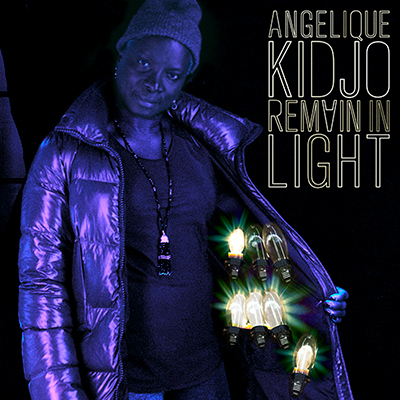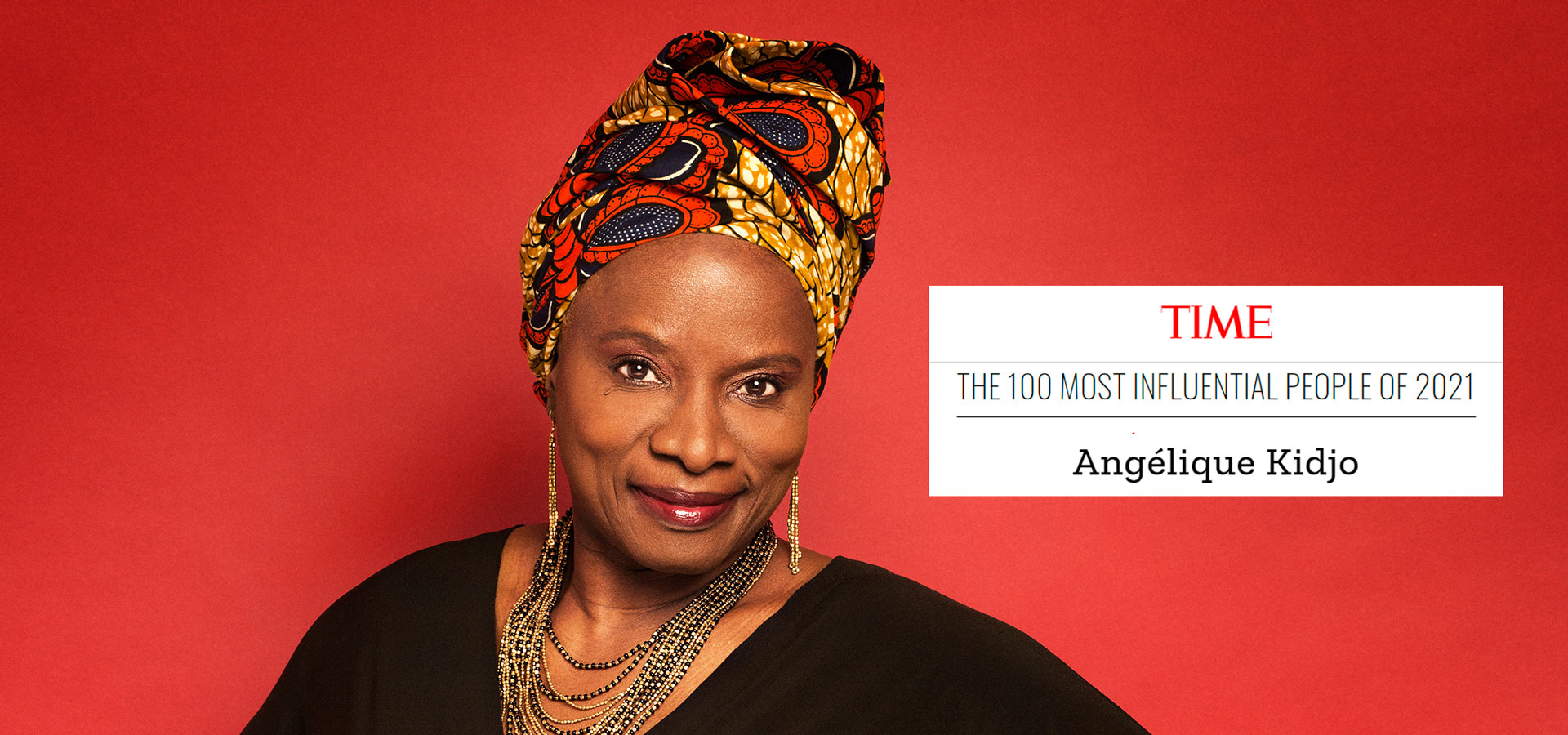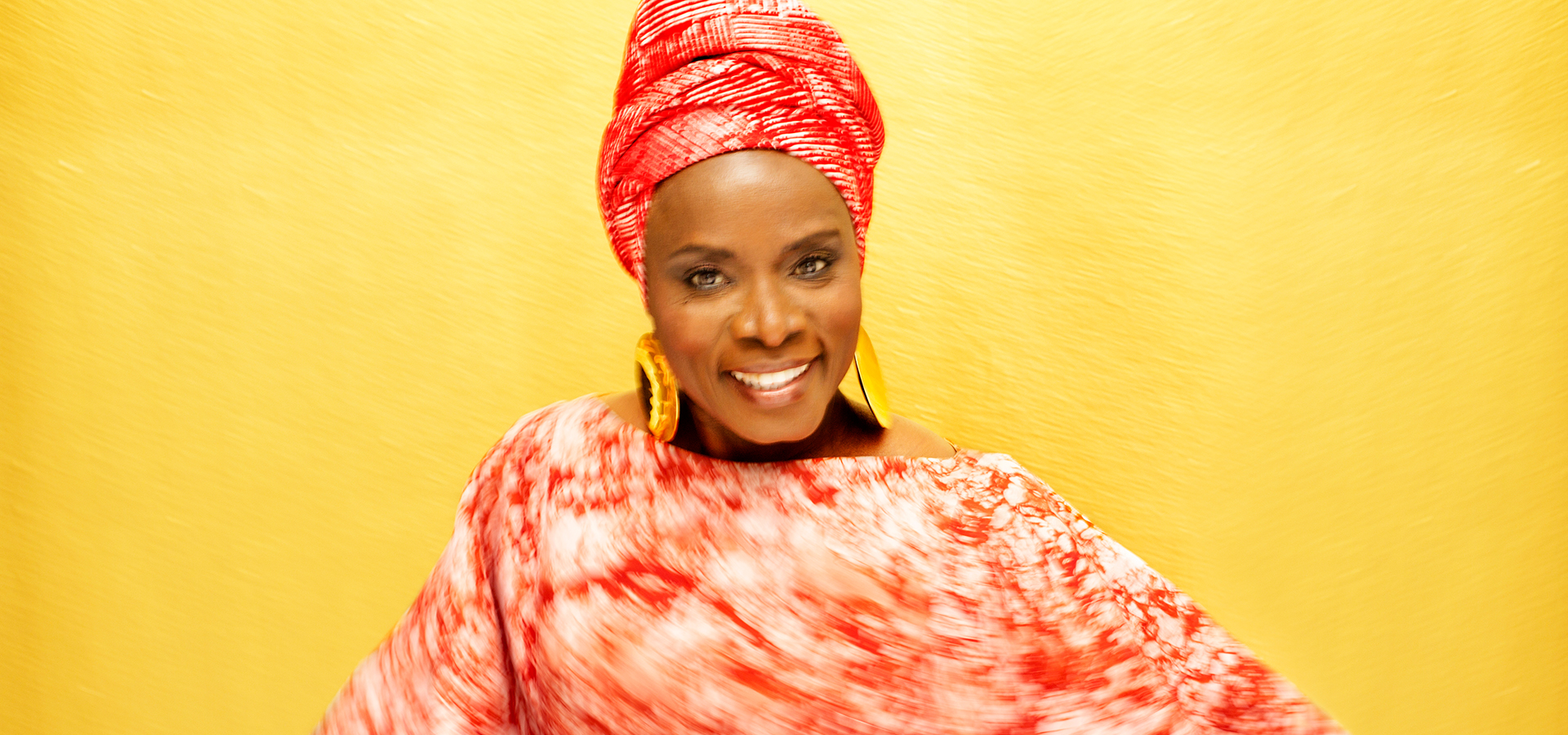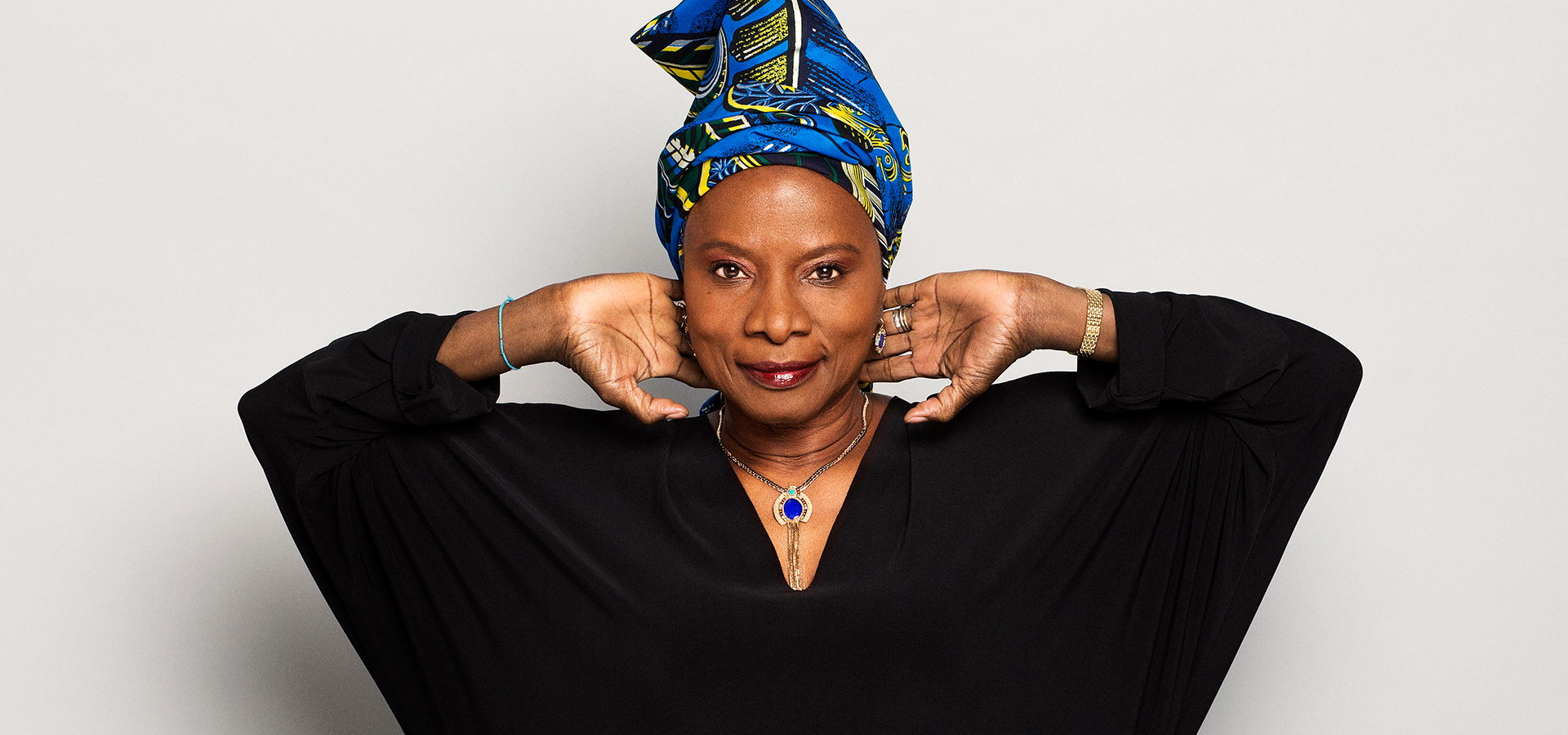Angélique Kidjo’s Remain in Light
Oct 29, 2021
Zellerbach Hall
Angélique Kidjo, lead vocals
Dominic James, guitar
Michael Olatuja, bass
Yayo Serka, drums
Magatte Sow, percussion
Patrick Murray, tour manager and sound engineer
This performance will last approximately one hour and 45 minutes and be performed without an intermission.
From the Executive and Artistic Director


Several years ago, I had the pleasure of witnessing the program you are about to experience; taking my seat on that occasion, I thought I had a pretty good idea of what to expect, but believe me, nothing could have prepared me for the supernova of energy that blasted from the stage when the great Angélique Kidjo and her A-team band launched into Kidjo’s vivid, pulsating, supremely confident and original retake on the Talking Heads’ iconic 1980 album Remain in Light.If you’ve already experienced Angélique in concert, you know what I’m talking about; if not, fasten your seat belts!
A few years later, when I accepted my new position at Cal Performances, one of my immediate and strongest desires was to bring Kidjo’s Remain in Light program to Berkeley audiences, so this evening’s concert represents something of a dream fulfilled. And I couldn’t be more pleased that you’ve joined us for the occasion.
Happily, there’s much more to come. If tonight’s concert concludes Kidjo’s opening week as Cal Performances’ first season-long artist-in-residence, I’m happy to confirm that Kidjo will be returning in April with more special events involving the university community, as well as the Bay Area premiere of her brilliant new Yemandja: A Story of Africa (a Cal Performances co-commission). Named for a Yoruban deity, Yemandja promises to be a panoramic work of magical realism, a parable about gods and humans that illuminates through song what can happen when people are robbed of their culture.
Kidjo’s appearance tonight serves as a rich reminder of the transformational power of the live performing arts. There’s truly nothing to compare with the alchemy that takes place when friends and strangers come together to experience great art—music, theater, dance—together under the same roof. I’m so pleased you could join us here this evening!
When the pandemic forced Cal Performances to close its doors in March 2020, no one could have imagined what lay ahead. Since then, we’ve witnessed a worldwide health crisis unlike any experienced during our lifetimes, an extended period of political turmoil, recurring incidents of civil unrest and racially motivated violence, and a consciousness-raising human rights movement that has forever—and significantly—changed how each of us views social justice in our time.
Of course, the pandemic remains with us to this date and future challenges—including many adjustments to “normal’ procedures and policies—can certainly be expected. I encourage you to check Cal Performances’ website regularly for the most current information regarding our COVID-19 response. First and foremost, I assure you that there is nothing more important to us than the health and safety of our audience, artists, and staff. (And I remind one and all that proof of vaccination is mandatory today, as is protective masking throughout the event.)
This weekend, October draws to a close with a special Halloween appearance by Chicago’s brilliant performance collective Manual Cinema in it’s wildly original production of Frankenstein, after which our season continues as New York’s pioneering Ballet Hispánico (Nov 6) makes
its Berkeley debut with a special 50th anniversary program. (Our full calendar offers much more of the same, packed with the kind of adventurous and ambitious programming you’ve come to expect from Cal Performances.) In particular, I want to direct your attention to this year’s Illuminations: “Place and Displacement” programming, through which we’ll explore loss and renewal, disempowerment and hope, while seeking paths forward for reclaiming and celebrating vital cultural connections that can fall victim to political and social upheaval.
Please take the opportunity to explore the complete schedule through our website and season brochure and begin planning your performance calendar; now is the perfect time to guarantee that you have the best seats for all the events you plan to attend.
Throughout history, the performing arts have survived incredible challenges: periods of war, economic collapse, and, yes, terrible disease. And if it will take time for us—collectively and individually—to process the events of the past 18 months, I’m certain that the arts have the power to play a critical role as we come to terms with what we have experienced and move together toward recovery.
I know you join us in looking forward to what lies ahead, to coming together once again to encounter the life-changing experiences that only the live performing arts deliver. We can’t wait to share it all with you during the coming year.
Cal Performances is back. Welcome home!
Jeremy Geffen
Executive and Artistic Director, Cal Performances
About the Performance

In 2018, global pop star and four-time Grammy Award winner Angélique Kidjo has partnered with 2015 Grammy Producer of the Year Jeff Bhasker (Kanye West, The Rolling Stones, Beyonce) for a full circle re-imagining of the Talking Heads’ 1980 landmark album Remain in Light (Kravenworks Records). The original album, considered to be one of the greatest of that decade, was influenced by music from West Africa, notably Fela Kuti’s Afrobeat. This remarkable new collaboration was seen as a radical statement and positioned the Benin-born artist in ways she had never been heard before.
The diverse cast of collaborators included Fela Kuti’s musical director Tony Allen on drums, Vampire Weekend’s Ezra Koenig singing in Kidjo’s native tongue of Fon, Black Panther film score percussionist Magatte Sow, Blood Orange’s Davonté Hynes, the Antibalas horns with arrangements by Martin Perna, legendary studio bassist Pino Paladino, Kidjo’s longtime guitarist Dominic James, and African jazz guitarist Lionel Loueke, among others. The album artwork was conceptualized by noted African-American visual artist Kerry James Marshall, who counts the original album as an important creative touchstone.
In 2017, Kidjo premiered this musical project at New York’s Carnegie Hall and at Bonnaroo (famously, David Byrne stepped from audience to stage to sing with Kidjo during the concert). The shows were met with rave reviews, and Kidjo continues to perform the program in concerts throughout the world.
Kidjo first crossed paths with the original album when she fled Benin and moved to Paris in 1983. She recognized the music as African, but the rhythms were harder for her to place. It stayed in her mind, but she kept it to herself because some of her music teachers and fellow students at the time dismissed her opinions because she was a young African woman who wouldn’t, in their opinion, know anything about rock and roll. But the idea of an album continued to inhabit her subconscious.
Still inspired by the experience of recording the celebratory material for 2014’s Eve, Kidjo took other songs and folkloric tales she heard while researching Eve and wove them into the fabric of the Remain in Light songs, which she first recorded as demos in her home studio. Later, when recording “Cross-eyed and Painless” with Tony Allen, she effortlessly dropped in lyrics from Fela Kuti’s 1970s classic “Lady,” reaffirming and strengthening that initial inspiration while extending it into something new, modern, and uplifting.
“I started working on Remain in Light and I would pick a song and it would match these Beninese traditional songs I heard,” she recalls. “It was just so organic and normal that the whole thing fell into place. You have all these puzzle piece—you see the picture appear and then you put the stuff in places.
“It was a challenge reinterpreting this iconic masterpiece,” says Bhasker. “We didn’t simply want to “cover” what the brilliant producer Brian Eno and revolutionary Talking Heads created, but rather put our own spin on it. Rip out its guts and turn it on its head. As they were inspired to take an African form and rock it, we took rock and brought it back to Africa. I think the result is a beautiful full-circle experience that I hope enhances both worlds and brings cultures closer together.”
Kidjo had met Bhasker at a benefit concert in London where he was the music director and she was a guest of honor. The two instantly hit it off, the only sticking point being trying to figure out what they would do together. They later met in Los Angeles, where Bhasker told her he just needed a kernel of an idea. A short time later, she sent him two Talking Heads demos—many of the vocal tracks were never rerecorded again because the demo performances were so strong—and a week later, he was onboard for the whole album.
“From the first day of the recording, we picked up right where we left off. It’s one of the most fun-filled and enriching projects I’ve ever worked on; it’s the reason I make music,” Bhasker explains.
Remain in Light was made anew. The first clue was the stunning new black-light photo of Kidjo by Kerry James Marshall. The African-ness of the sound comes out through the same mesmerizing African polyrhythms that made the original music so ground-breaking, but there are also different languages echoed in counter melodies of the haunting “The Overload,” the edgy “Listening Wind,” and others that are added by Kidjo.
The delivery of David Byrne’s lyrics is a classic study in contrasts while embracing the bigger ideas. Whereas the vocals were originally self-conscious, arty, ironic, and sometimes alienated, Kidjo’s voice and additional lyrics are a clarion call that sheds new light on the politics in “Born Under Punches,” the empowerment of women on the “Great Curve,” and the issue of tackling the African skin bleaching phenomenon on “Seen and Not Seen.”
“When it comes to music, I don’t have much fear,” says Kidjo, who is also renowned for her humanitarian efforts. “If you are inspired to do something, then there is truth in that. My music has been a weapon for constructing bridges. We have so much in common, yet we are so divided that we may not take a pause to think about what we may have in common. We think things divide us, but not much truly divides us.”









